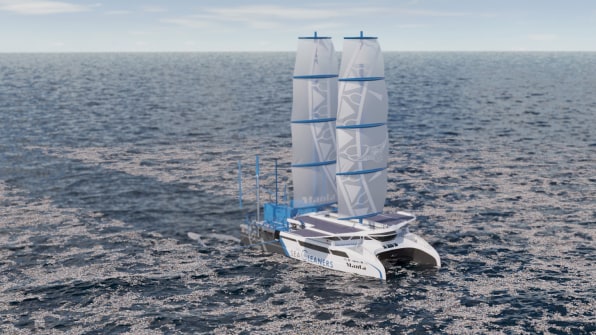One boat won’t make much of a dent in the ocean plastic problem itself, but the Manta could illustrate new solutions.

When the Manta begins traveling along coastlines in 2024, the new sailboat will pull plastic trash from the water as it moves, capturing as much as three tons of plastic per hour. On board, the plastic will then go through a waste-to-energy machine that turns it into electricity to provide some of the boat’s power.

The boat, which is still in the concept stage, was inspired in part by the manta ray, which eats as it swims with an open mouth. As the boat moves through the water, it will pull plastic up conveyor belts located between its hulls. Off the back of the boat, nets will catch larger pieces of plastic below the surface of the water. Two smaller boats can be deployed to travel separately and collect more plastic in shallow water or narrow passages.

Unlike the Ocean Cleanup, a project that collects plastic using huge floating barriers in the ocean or robots in rivers and then brings the plastic back to recycling plants so it can be made into new products, the boat won’t carry plastic back to shore. Instead, after workers on board separate the collected trash, pulling out aluminum and other materials, the plastic will be crushed, turned into pellets, and then vaporized using a pyrolysis system that converts it into a synthetic gas that makes electricity that’s stored in batteries on the boat. The batteries can then power the propellers, navigation system, and other electrical equipment. The small amount of carbon that’s left would be be recycled on land.

The point of the boat, is that “nothing should be wasted,” says Valérie Amant, communications director for SeaCleaners, the nonprofit building the boat. “Everything we collect and transform on board the Manta will be converted into something valuable according to the principles of circular economy.”

The plastic can’t fully power the boat, it has an engine, but it will also uses large sails, two wind turbines, and solar panels, so it can move without any fossil fuels most of the time. But it’s an interesting way to supplement the boat’s power, and could conceivably be used even in much larger cargo ships as they cross the ocean. “Using plastics to produce energy, whether it is oil or electricity, like in the Manta, is a technology that has existed for quite some time now,” she says. “The challenge is to ‘marinize’ this technology, embark it on a workboat and make it fit in given all the different other missions that a cargo ship needs to fulfill.”

The nonprofit, which was founded by sailor Yvan Bourgnon after he witnessed the increasing amount of plastic trash in the ocean—several million additional metric tons every year—plans to begin construction of the vessel in late 2022, and then begin to sail in 2024, operating 300 days per year. The 56-meter-long boat will have room for 34 people on board: 22 crew, three waste sorters, two operators of the waste-to energy-unit, along with 6 to 10 scientists.
The nonprofit wants to inspire others to build similar systems. “It’s easy to give up when faced with the magnitude of the problem, to think that there’s no point in collecting [ocean plastic],” Amant says. “We don’t think so. … We want to show that collection and recovery technologies are efficient and affordable, and thus encourage public and private players to take them on board.” A single boat, of course, won’t do much given the scale of the problem. “A fleet is needed,” she says.
